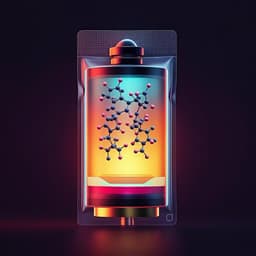
Chemistry
A locally solvent-tethered polymer electrolyte for long-life lithium metal batteries
Y. Zhu, Z. Lao, et al.
Discover an innovative approach to enhancing lithium-ion conductivity with a new composite polymer electrolyte, developed by a team of researchers including Yanfei Zhu and Zhoujie Lao. This breakthrough utilizes a Hofmann-DMF coordination complex, achieving impressive ionic conductivity and exceptional cycling stability.
~3 min • Beginner • English
Introduction
Solid polymer electrolytes (SPEs) are promising for next-generation solid-state batteries due to processability and safety, but their room-temperature ionic conductivity is limited by sluggish polymer segmental motion and weak salt solvation (typically 10−8–10−5 S cm−1). High-dielectric, low-viscosity solvents such as NMP, DMSO, and especially DMF (εr = 36.7; η = 0.82 mPa s) can plasticize SPEs, coordinating Li+ via DMF carbonyl oxygen to enhance salt dissociation and cation transport. However, DMF co-migrates with Li+ to the lithium metal anode, decomposes, and destabilizes the SEI, causing rapid capacity fade and electrolyte depletion. Prior additive strategies improve either conductivity (e.g., inorganic fillers) or interfacial stability (e.g., polymer additives), but often dilute DMF or fail to suppress its shuttling, leaving a trade-off and unclear synergistic transport mechanisms. The study targets a strategy that simultaneously boosts ionic conductivity and interfacial stability by confining DMF locally to promote Li+ transport while preventing its migration and degradation. Layered Hofmann frameworks with tunable ligation and open metal sites are proposed to tether DMF and assist salt dissociation, enabling a dual-functional additive for composite polymer electrolytes.
Literature Review
Additive engineering has been widely explored to address SPE limitations: organic additives (e.g., poly(acrylic acid)) can strengthen SEI and mitigate DMF–Li reactions but dilute DMF, compromising salt dissociation and conductivity. Composite polymer electrolytes with inorganic fillers reduce polymer crystallinity and create additional Li+ pathways. Dielectric ceramics (e.g., garnet LLZTO derivatives, LATP, BaTiO3-based) have been used to promote salt dissociation and sorb DMF, but most approaches optimize either conductivity or stability alone. Hofmann-type coordination frameworks provide metal-rich sites and ligand exchangeability (H2O, NH3, organics), offering opportunities to confine functional solvents and immobilize anions via metal–anion interactions. The gap remains in achieving synergistic DMF modulation with a clarified Li+ transport mechanism across complex components to attain both high conductivity and durability in polymer electrolytes.
Methodology
- Design and synthesis of Hofmann-based additive: A precursor Ni(H2O)2Ni[CN]4·xH2O (Ni-H2O) was synthesized by coprecipitation of [Ni(CN)4]2− with Ni2+, forming layered nanosheets with coordinated and absorbed water. Thermal dehydration under vacuum yielded an activated Ni(H2O)2Ni[CN]4 (Ni-activated) with enlarged interstitial channels. Ligand exchange was performed by immersing Ni-activated in excess DMF to obtain Ni(DMF)2Ni[CN]4 (Ni-DMF) with increased lattice spacing and surface area.
- Structural and spectroscopic characterization: SEM/TEM for morphology; N2 adsorption/ BET; PXRD for phase verification; STXM/XANES at O K-edge and Ni L-edge to confirm H2O→DMF ligand exchange and metal–ligand interactions; ATR-FTIR for functional groups; EXAFS to analyze local bonding (Ni–O bond length changes). DFT computed Gibbs free energies for ligand substitution and HOMO analyses of bonding characteristics.
- Composite polymer electrolyte fabrication: PVDF-HFP and LiFSI dissolved in DMF to form the liquid polymer electrolyte (LPE). Ni-DMF nanosheets were dispersed to form LPE@Ni-DMF membranes via doctor-blade casting and solvent evaporation. Thickness, morphology, uniformity, and mechanical properties were examined by SEM, XCT 3D reconstruction, and film stress measurements.
- Electrochemical characterization: Ionic conductivity measured in SS|SSE|SS cells by EIS over 100 kHz–0.1 Hz; Arrhenius activation energies computed. Li+ transference number measured by potentiostatic polarization and EIS in Li|SSE|Li. Electrochemical stability window assessed by LSV in Li|SSE|SS. Li|Li symmetric cells tested for long-term cycling, overvoltage, and critical current density (CCD). Exchange current density extracted from CV/Tafel analysis. Li|SSE|SPAN coin cells evaluated for rate and long-term cycling at room and low temperatures; in situ EIS and DRT analyses deconvolved SEI, charge transfer, and diffusion contributions. Pouch cells assembled (SPAN cathode, Li anode) to demonstrate practical performance.
- Chemical/structural analyses of electrolytes and SEI: 7Li ssNMR for Li environments and mobility; Raman for FSI speciation (free, contact ion pairs, aggregates); TG to quantify DMF content change after cycling; 2D-WAXS/XRD for crystallinity and structural evolution; XPS depth profiling for SEI composition; cryo-TEM/FFT for SEI microstructure and phase identification.
- Modeling and simulations: Classical MD (LAMMPS) with UFF/OPLS-AA-based force fields to probe Li+ solvation, DMF tethering/detethering dynamics, RDFs, coordination numbers, residence times, diffusion lengths, and anion immobilization at Ni-DMF interfaces. FEM (COMSOL) simulated DMF corrosion of Li, SEI growth, ionic conductivity distribution, overpotentials, local current density, and Li deposition morphology using Nernst–Planck transport, Butler–Volmer kinetics, and Level Set dynamic mesh for interfacial evolution.
Key Findings
- DMF-tethered Hofmann additive: Successful ligand exchange to form Ni(DMF)2Ni[CN]4 (Ni-DMF) with increased interlayer spacing (7.63 Å) and higher BET surface area (59.7 m2 g−1). O K-edge STXM/XANES confirmed H2O→DMF substitution; Ni L-edge indicated reduced charge transfer for Ni–DMF vs Ni–H2O; EXAFS showed longer Ni–O(DMF) bond (1.77 Å vs 1.74 Å), consistent with electrostatic interactions and stable tethering.
- Ionic transport enhancement: LPE@Ni-DMF achieved high ionic conductivity; reported as 6.5 × 10−4 S cm−1 at room temperature (abstract/discussion). Within the PVDF-HFP system, LPE@Ni-DMF exhibited 6.5 × 10−5 S cm−1 at 25 °C vs 2.4 × 10−7 S cm−1 for LPE; activation energy reduced to 0.147 eV (vs 0.218 eV). Li+ transference number increased to 0.71 (from 0.44). Low-temperature conductivities reached 2.55 × 10−4 S cm−1 at 0 °C and 1.26 × 10−4 S cm−1 at −10 °C.
- Ligand-assisted Li+ transport mechanism: MD revealed attach–guide–detach behavior of DMF ligands at Ni-DMF interfaces, enabling Li+ hopping while minimizing DMF co-diffusion. Coordination environment shifted toward DMF-rich solvation at interfaces: Li–O(DMF) coordination number increased to 3.8 (vs 1.02 in LPE), Li–O(DMF) distance lengthened to 2.11 Å (vs 2.05 Å), and Li–O(FSI) contribution decreased due to FSI immobilization on Ni sites. Residence times of Li+/DMF and Li+/FSI pairs decreased by ~60% vs LPE.
- Reduced DMF shuttling and improved durability: TG showed smaller post-cycling DMF weight loss (ΔW) of 1.7% in LPE@Ni-DMF vs 7.5% in LPE. WAXS indicated stable Ni-DMF structure and preserved amorphous character in LPE@Ni-DMF upon cycling; mechanical modulus increased to 13.3 MPa (~3× LPE).
- Electrochemical stability and interfacial properties: LSV oxidation onset shifted to >4.7 V for LPE@Ni-DMF (vs ~4.3 V for LPE). Li|LPE@Ni-DMF|Li symmetric cells cycled stably for 6250 h at 0.1 mA cm−2 with low overvoltage (64 mV) and higher CCD (1.0 mA cm−2 vs 0.3 mA cm−2). Exchange current density increased to 0.69 mA cm−2 (vs 0.24 mA cm−2). XPS/cryo-TEM showed anion-derived, inorganic-rich SEI (LiF- and Li2O-rich) with higher F/C ratio and layered F distribution (surface −SO2F, inner LiF) vs organic-rich and heterogeneous SEI for LPE.
- Battery performance: Li|LPE@Ni-DMF|SPAN coin cells delivered high rate capacities at room temperature (e.g., 899 mAh g−1 at 0.3 C; 872 at 0.5 C; 811 at 1 C) and long-term cycling (961 mAh g−1, 81.9% retention after 300 cycles at 0.2 C). At 1 C, 1000 cycles with 60% capacity retention and 99.8% average CE, while LPE failed after ~100 cycles (96.7% CE). Excellent low-temperature operation: at −10 °C, 835 mAh g−1 (52% of 20 °C capacity) vs 86.5 mAh g−1 (13%) for LPE. Pouch cell (SPAN 2 mg cm−2; 50 mg S) achieved 47 mAh total capacity and 1.9 mAh cm−2 areal capacity with ~950 mAh g−1 after 35 cycles and overlapping profiles, demonstrating practicality.
Discussion
Tethering DMF ligands on layered Hofmann frameworks creates locally DMF-rich interfaces that foster a ligand-assisted Li+ transport mechanism while suppressing DMF migration to the Li anode. This dual action resolves the conventional trade-off between conductivity and interfacial stability in solvent-containing polymer electrolytes. MD and spectroscopic analyses substantiate that interfacial DMF coordination increases solvent participation in Li+ solvation and decouples Li+ from the FSI anion, aided by anion immobilization on Ni sites. Experimentally, this yields higher conductivity, higher Li+ transference number, lower activation energy, and improved electrochemical stability window. Confining DMF mitigates its depletion and supports a predominantly amorphous, mechanically stronger membrane. At the anode, an anion-derived, LiF/Li2O-rich SEI forms rapidly and remains thin and uniform, enabling higher exchange currents, reduced overpotentials, and dendrite-suppressing, uniform Li deposition. These interfacial and transport advantages translate to long-lived Li|Li symmetric cycling, robust Li|SPAN performance at high rates and low temperatures, and reproducible pouch-cell operation, advancing polymer-based solid-state lithium–sulfur batteries.
Conclusion
The study introduces a locally solvent-tethered composite polymer electrolyte using a DMF-ligated Hofmann framework (Ni-DMF) as a dual-functional additive that both enhances Li+ transport and stabilizes the Li interface. By confining DMF at additive–polymer interfaces, the electrolyte achieves high room-temperature ionic conductivity (reported up to 6.5 × 10−4 S cm−1), elevated Li+ transference number (0.71), suppressed DMF shuttling, and the formation of an inorganic-rich, LiF-dominated SEI. These effects enable ultralong Li|Li cycling (>6000 h at 0.1 mA cm−2), high CCD (1.0 mA cm−2), exceptional Li|SPAN coin-cell durability (1000 cycles at 1 C) and low-temperature performance, as well as practical pouch-cell operation with 1.9 mAh cm−2 areal capacity. The demonstrated ligand-assisted transport and solvent-confinement design principle is generalizable to other polymer electrolytes and solid-state battery chemistries.
Limitations
Related Publications
Explore these studies to deepen your understanding of the subject.







